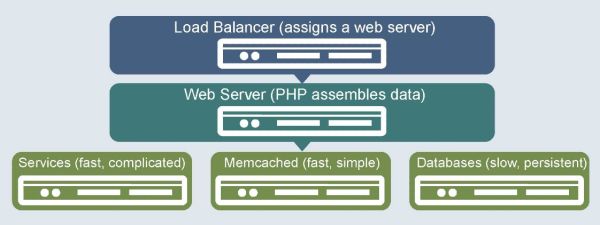Facebook's "Open Compute" Server tested
by Johan De Gelas on November 3, 2011 12:00 AM ESTCloud = x86 and open source
From a high-level perspective, the basic architecture of Facebook is not that different from other high performance web services.
However, Facebook is the poster child of the new generation of Cloud applications. It's hugely popular and very interactive, and as such it requires much more scalability and availability than your average website that mostly serves up information.
The "Cloud Application" generation did not turn to the classic high-end redundant platforms with heavy Relational Database Management Systems. A combination of x86 scale-out clusters, open source websoftware, and "no SQL" is the foundation that Facebook, Twitter, Google and others build upon.
However, facebook has improved several pieces of the Open Source software puzzle to make them more suited for extreme scalability. Facebook chose PHP as its presentation layer as it is simple to learn, write, and read. However, PHP is very CPU and memory intensive.
According to Facebook’s own numbers, PHP is about 39 times slower than C++ code. Thus it was clear that Facebook had to solve this problem first. The traditional approach is to rewrite the most performance critical parts in C++ as PHP Extensions, but Facebook tried a different solution: the engineers developed HipHop, a source code transformer. Hiphop transforms the PHP source code into faster C++ code and compiles it with g++.
The next piece in the Facebook puzzle is Memcached. Memcached is an in-RAM object caching system with some very cool features. Memcached is a distributed caching system, which means a memcached cache can span many servers. The "cache" is thus in fact a collection of smaller caches. It basically recuperates unused RAM that your operating system would probably waste on less efficient file system caching. These “cache nodes” do not sync or broadcast and as a result the memory cache is very scalable.
Facebook quickly became the world's largest user of memcached and improved memcached vastly. They ported it to 64-bit, lowered TCP memory usage, distributed network processing over multiple cores (instead of one), and so on. Facebook mostly uses memcached to alleviate database load.












67 Comments
View All Comments
jhh - Saturday, November 5, 2011 - link
I'm not sure how much of the benchmarks depend on network bandwidth, but Facebook certainly does a lot of it. Using SRIOV based NICs and supporting drivers allows the VM to access virtual NIC hardware directly, without having to go through the hypervisor. But, all NICs aren't built equal, many of them do not support SRIOV, and those that do, may not have drivers which support it in older kernels such as Centos 5.6. Unfortunately, since most Gigabit NICs were designed before SRIOV, most gigabit NICs don't support it. We have great difficulty getting hardware vendors to describe whether the provide SRIOV capable hardware or Linux drivers. The newer 10G NICs tend to support SRIOV, but whether the server needs more than 1G is unclear, and the 10G NICs are more expensive and use more power.CPU-Hog - Sunday, November 6, 2011 - link
Good comparison of the servers however I couldn't help but think how much better it would be if we ran actual workloads that facebook etc plan to run in the datacenter vs. these enterprise workloads. How about running MemcacheD / Hadoop / HipHop etc. which are the key workloads the OpenCompute servers are designed to run well.Many of these workloads need large IO and memory vs. high compute. It will also be interesting to then use the same benchmarks to compare future servers based on technology from newbies like Calxeda, SeaMicro and AppliedMicro.
Xeon and Opterons based servers vs. ARM and Atom based servers. Now that battle of the old guard vs, the upstarts will be worth seeing.
trochevs - Wednesday, November 9, 2011 - link
Johan,Thank you for excellent article. I love to read about cutting edge technology. Keep with the good work. But, I notice something that nobody in the comments has mention yet. In the last paragraph:
"... being inspired by open source software (think ..., ..., iOS, ...)."
iOS is a Open Source Software?! When this happen?
mrgadgetgeek - Thursday, November 10, 2011 - link
Since these systems are custom designed by Facebook engineers, I'm guessing you can't purchase anything like it, correct? Will that change with that foundation that Open Compute announced recently?artemisgoldfish - Thursday, November 10, 2011 - link
Getting Power One to design a supply just right requires a LOT of testing. It's also strange to me that the supply only takes 200-277VAC. The Power One AC supplies I'm familiar with do 90VAC to 264VAC and pass 80PLUS Gold, maybe the tighter input range helps them tune it for more efficiency.ahmetmy330 - Friday, December 30, 2016 - link
you are free of charge to sort any sum of money in you intend to put in your Jurassic World job application. When using the formulated 100 % free Income and Nourishment it will be possible to fundamentally discover and acquiring everything around Jurassic World free of chargehttp://www.h2kjamaica.com/jurassicworldhack/
Chapon788 - Saturday, January 28, 2017 - link
Great Information sharing .. I am very happy to read this article .. thanks for giving us go through info.http://ultimatemobilehits.com/king-of-avalon-hack/